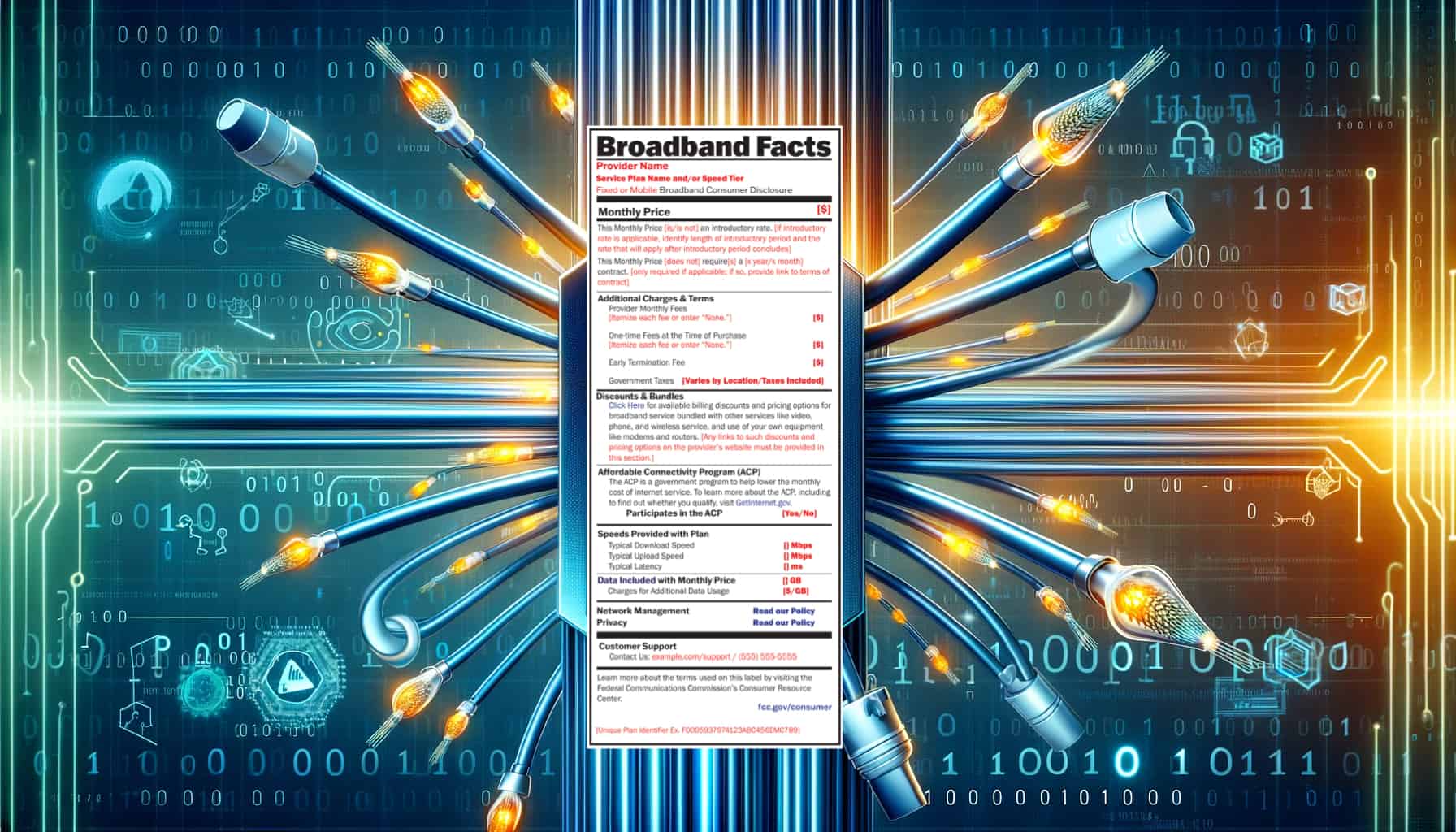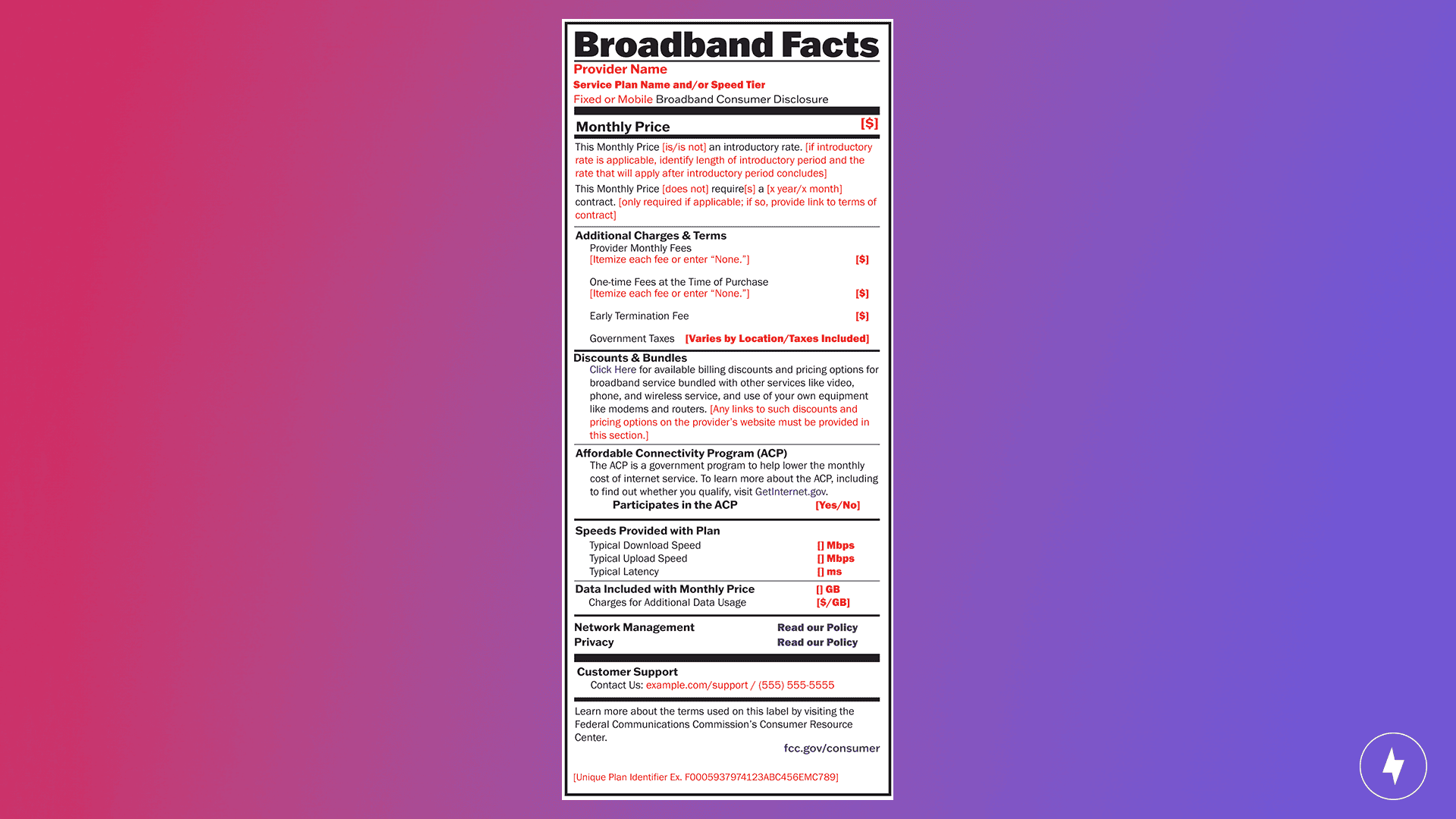FCC Broadband Consumer Nutrition Labels, Explained
The FCC’s new broadband ‘nutrition’ labels are designed to inject clarity into the often confusing process of shopping for broadband.

In a landmark decision aimed at enhancing consumer transparency and choice in broadband services, the Federal Communications Commission (FCC) has introduced a new regulatory requirement for internet service providers (ISPs) to display “broadband nutrition labels.”
The initiative is a key component of the wider Infrastructure Investment and Jobs Act (IIJA) and mirrors the concept of nutrition labels on food products, providing a standardized format for ISPs to present critical information about their broadband services.
Finding Your Broadband Labels: Looking for the broadband labels associated with your local internet providers? Search our Broadband Consumer Labels Hub to find all the details about your current or future internet plan.
Overview of Broadband Consumer Labels
- Our Video on Broadband Consumer Labels
- Objective of the Broadband Nutrition Labels
- Aligning With Legislative Mandates
- Implementation Timeline
- Content of the Labels
- Presentation and Accessibility of Labels
- Future Considerations and Potential Additional Rules
- The Impact of Broadband Nutrition Labels
- Looking Ahead
- Frequently Asked Questions About Broadband Consumer Labels
Our Video on Broadband Consumer Labels
Want the short version of this guide? Check out our video:
Objective of the Broadband Nutrition Labels
The primary goal of these labels is to demystify broadband service offerings for consumers, enabling them to make informed decisions when choosing their internet service providers. By standardizing the presentation of information, the labels aim to:
- Enhance transparency: Consumers will have access to clear and consistent information about prices, speeds, and other critical service aspects, helping them understand and compare internet offerings without confusion.
- Promote fair competition: With a standardized labeling system, ISPs are encouraged to compete fairly based on the quality and value of their services, rather than obfuscating details in fine print.
- Empower consumer choice: By providing comprehensive details in an accessible format, the labels empower consumers to choose services that best fit their needs and budgets.
Aligning With Legislative Mandates
The FCC’s decision is in direct response to the mandates set forth in the IIJA, reflecting a concerted effort by the Biden Administration to ensure greater consumer protection and fairness in the rapidly evolving digital landscape. The move is a significant step toward bridging the information gap that often leaves consumers at a disadvantage in understanding and selecting internet services.
The introduction of broadband nutrition labels is expected to bring a paradigm shift to how consumers interact with and choose their ISPs. It’s not just a regulatory change, but also a move toward fostering a more informed and empowered consumer base, which is essential in the age of digital necessity.
Implementation Timeline
The FCC has outlined a phased implementation plan for the broadband nutrition labels, taking into account the varied sizes and capabilities of ISPs. The approach is designed to ensure a smooth transition while accommodating the operational differences among ISPs.
- Larger ISPs (over 100,000 subscribers): ISPs with more than 100,000 subscriber lines are required to comply with the new labeling regulations by April 10, 2024. The earlier deadline for larger providers reflects their greater resources and capacity to adapt to regulatory changes.
- Smaller ISPs (fewer than 100,000 subscribers): Smaller ISPs have a slightly extended timeline, with a compliance deadline set for Oct. 10, 2024. That consideration acknowledges the potential challenges smaller entities face in implementing the changes.
The staggered deadlines aim to balance the need for swift implementation with the practical realities of diverse ISP operations.
Content of the Labels

The broadband nutrition labels are designed to provide consumers with a wide range of information about broadband services. The labels are structured to ensure transparency and ease of comparison across ISPs. The labels’ key components are outlined below.
Pricing Details
- Base monthly price: Clearly state the basic charge for the service.
- Additional fees: List any one-time or recurring fees separate from the base price, such as installation charges or equipment rental fees.
- Promotional rates: Disclose the length of promotional pricing and the cost after the promotion ends (if applicable).
- Term commitments: Include information on any required service commitments and associated terms.
- Bundling options: Links to information about discounts for bundling broadband with other services.
Data Allowance and Charges
- ISPs must disclose the amount of data the plan includes and any charges for exceeding the allowance.
- A link to detailed data-allowance information should be provided.
Speed and Performance
- Typical download and upload speeds for each plan.
- Information on latency figures, with ISPs having flexibility in data-collection methods.
Additional Disclosures
- Links to the ISP’s privacy policy and network-management disclosures.
- Information about the FCC’s Affordable Connectivity Program, including whether the ISP participates.
- Customer support contact information.
- A unique identifier for each plan (per FCC guidelines).
Accessibility and Compliance
- Machine readability: All labels must be machine-readable, in formats such as CSV, accessible via the ISP’s website.
- Accessibility for people with disabilities: ISPs are required to follow the Americans With Disabilities Act and associated Department of Justice guidance, ensuring labels are accessible to all consumers.
Regular Updates and Recordkeeping
- Dynamic information: ISPs must update labels each time there’s a change in any available plan.
- Recordkeeping: ISPs are required to archive all labels and retain evidence to support the accuracy of the labels’ content for two years beyond the retirement of a plan.
One-Year Post-Implementation Requirement
One year after the FCC’s Order approval, ISPs that offer an online customer portal must make the broadband label of a stand-alone broadband plan available on the portal. The requirement, however, does not extend to bundled plans or plans that were no longer offered as of the effective date of the new rules.
Presentation and Accessibility of Labels
Visibility at Points of Sale
The FCC mandates that broadband nutrition labels must be prominently displayed, ensuring they are easily accessible to consumers at all points of sale. How it will work in practice depends on the context.
- Online visibility: ISPs are required to display the labels on their websites. They don’t need to be shown before a visitor specifies their service location, however, ensuring that only relevant plans are displayed.
- In-store presentation: Labels should be clearly visible in physical retail locations where broadband services are sold.
- Telephone sales: When accepting orders over the phone, ISPs can provide the label via text or email in real time. Alternatively, they can direct the caller to a website where the label is displayed. ISPs must document each instance in which a consumer is directed to an alternate channel for label access.
Accessibility for All Consumers
The labels must support machine-readability, such as providing the information in a spreadsheet file format on the ISP’s website. In line with the Americans With Disabilities Act, the labels must also be accessible to people with disabilities. That includes considering alternate formats such as Braille, large print materials, or other effective methods for making visually delivered materials available to individuals with visual impairments.
ISPs are strongly encouraged to comply with the Web Content Accessibility Guidelines (WCAG), ensuring that online labels are accessible to as many users as possible.
Future Considerations and Potential Additional Rules
The FCC’s new labels may need to evolve over time to further address consumer needs and industry trends. Future enhancements could include more detailed pricing information, addressing complexities in bundled plans, and enhancing label accessibility in line with the WCAG.
The labels may also incorporate extensive details on service reliability, performance under various conditions, and insights into ISPs’ cybersecurity and data-privacy practices. There’s also consideration for offering labels in multiple languages and exploring interactive or alternative formats to improve clarity and effectiveness.
Those potential developments reflect a commitment to adapting the labels to the dynamic needs of consumers and the evolving broadband market. The FCC may seek comments and feedback from stakeholders, including consumers, ISPs, and advocacy groups, to refine the potential rules and ensure they address the needs of all parties effectively.
Any additional rules or changes will be subject to the prevailing legal and regulatory environment. The FCC’s actions may be influenced by shifts in the political landscape, technological advancements, and evolving consumer needs.
The Impact of Broadband Nutrition Labels
The FCC’s initiative to introduce broadband nutrition labels is a major step forward for consumers. The move is also poised to significantly impact ISPs in several ways.
The labels provide a comprehensive and standardized format for presenting critical information about broadband services, empowering consumers to make informed choices based on clear, transparent data about pricing, data allowances, speeds, and more.
By standardizing how information is presented, the labels encourage ISPs to compete on service quality, price, and value rather than relying on confusing or hidden terms. The internet is integral to daily life, so the labels address the growing need for consumers to have easy access to detailed information about their internet services.
The requirement for ISPs to regularly update and maintain accurate labels ensures ongoing accountability and responsiveness to consumer needs and market changes. The initiative could set a precedent for other sectors, demonstrating how transparency and standardization can benefit consumers in complex service industries.
Looking Ahead
As technology and consumer needs evolve, the FCC’s approach to broadband nutrition labels may also evolve. Potential future enhancements, such as expanding language options, including more detailed performance characteristics, and addressing cybersecurity concerns, indicate a dynamic regulatory approach aligned with technological advancements and consumer advocacy.
The broadband nutrition labels are more than just a regulatory requirement. They represent a significant shift in the industry toward greater consumer empowerment and industry transparency. The labels ideally will become a standard part of broadband service offerings, and they’re expected to play a crucial role in how consumers understand, compare, and select their internet services, contributing to a more informed and connected society.
Frequently Asked Questions About Broadband Consumer Labels
Are broadband consumer labels mandatory for all ISPs?
Yes, any provider that offers broadband internet service must have a broadband consumer label
What if my ISP doesn’t list their broadband consumer labels?
Some ISPs will first prompt you to enter your address or zip code to see if their internet service is available in your area before listing their internet plans and displaying the relevant broadband consumer labels.
Are discounted prices or programs included in the broadband consumer label?
No, discounted programs are not included in a broadband consumer label. Discounts and bundles on internet services are included in their own section. Otherwise, the prices listed on a broadband consumer label must be the base price and not include any discounts.
What does the unique identifier look like on a broadband consumer label?
The unique identifier is specific to each ISP and appears on the label without spaces. Since they are unique to each plan, they cannot be reused for newer internet plans, even if the identifier came from a discontinued plan.
Do ISPs need to keep their broadband consumer labels after discontinuing their plans?
Yes. Per FCC regulations, ISPs must archive broadband consumer labels for discontinued internet plans for a minimum of two years.